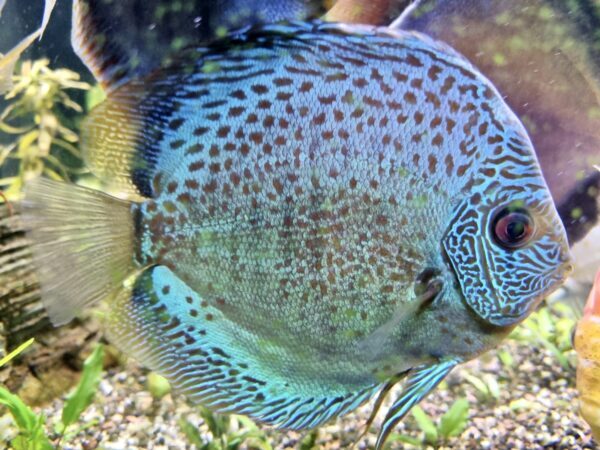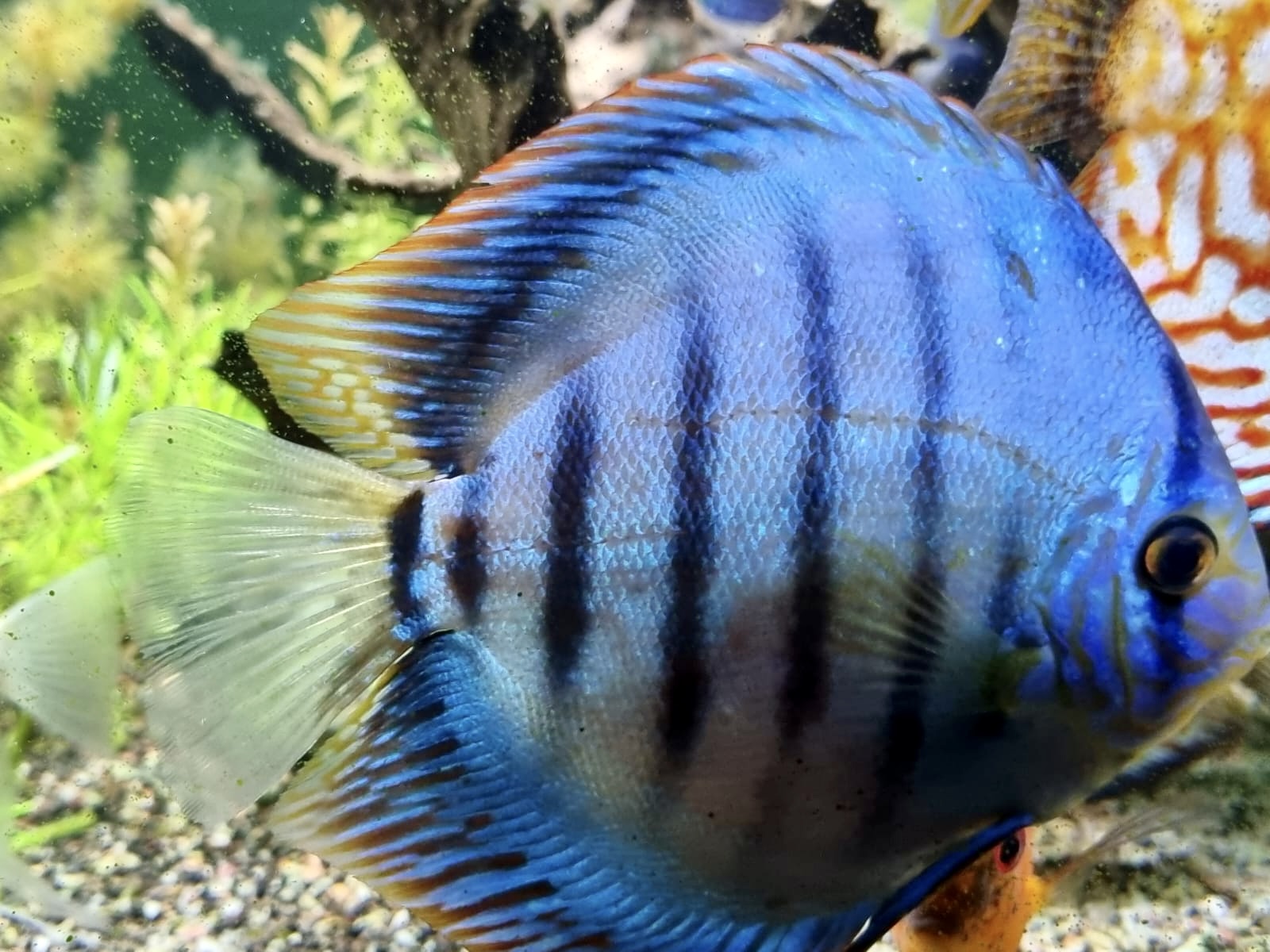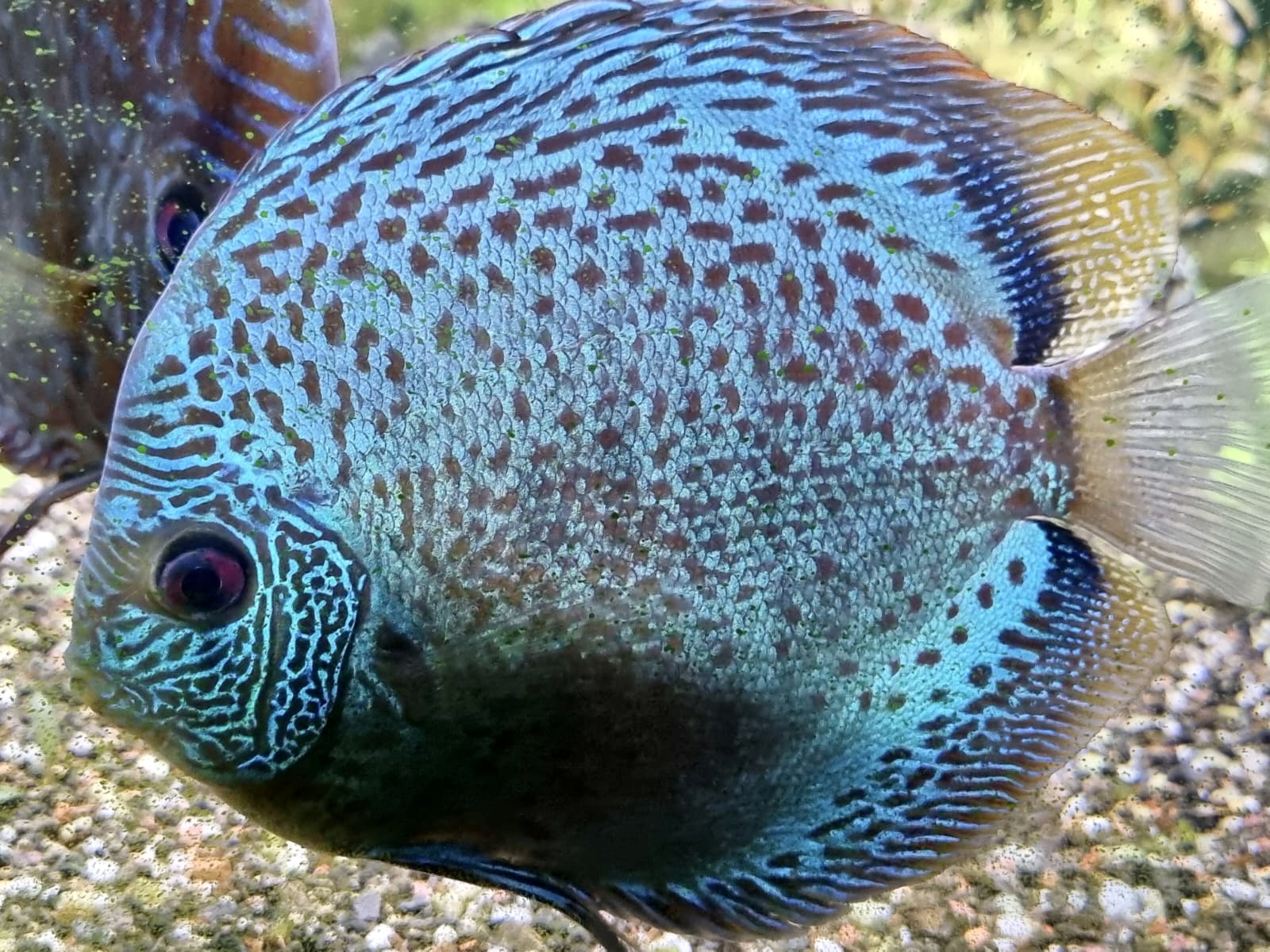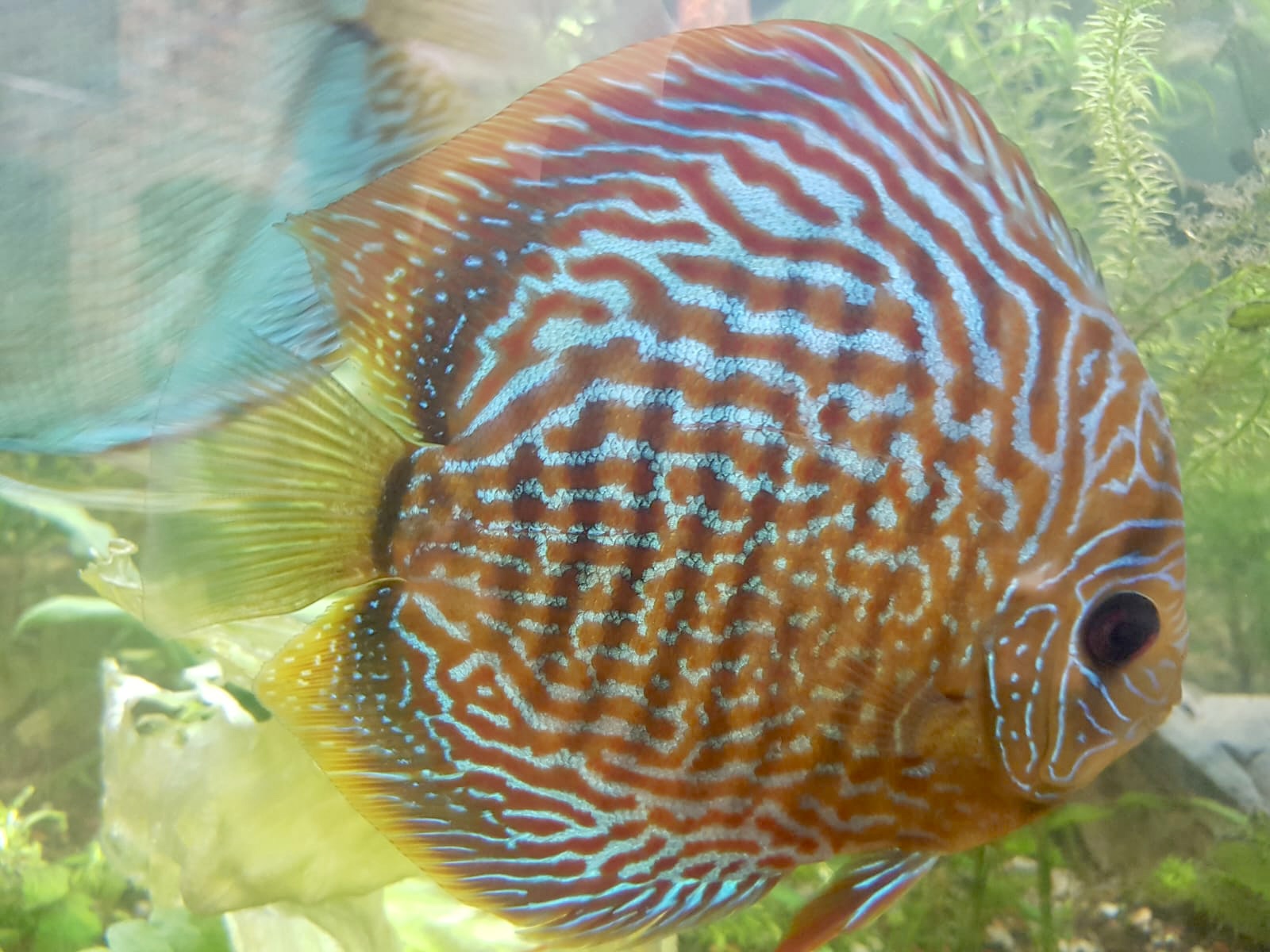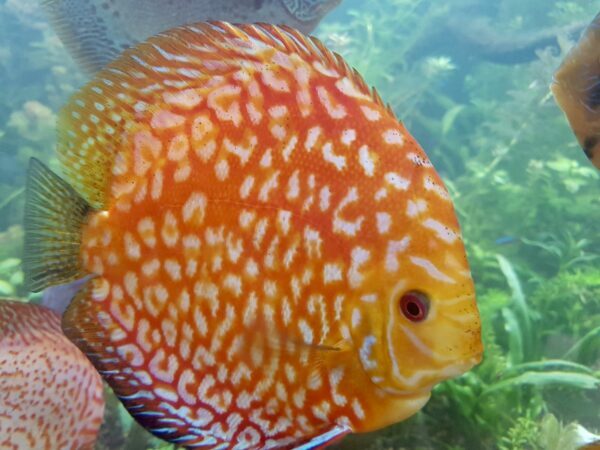Currently I boast a large collection of exotic Discus fish, as they are commonly known, due to their ‘disc-like’ shape. Their scientific name being Symphysodon.
The Discus are a genus of Cichlidae, which are native to the Amazon River basin in South America.
As you can tell from the video clips they are extremely tame and trusting of me. What’s more, when I submerge my hand into the tank, which I access from behind they gather around when I call to them. In addition to the large display aquarium, I house a collection of 6 smaller breeding and recuperation tanks that are concealed from view, which I can access from behind the display tank.
We have included official References below should you wish to learn more about the Discus..
References:
- Loiselle, Paul V. (1995). The Cichlid Aquarium. Germany: Tetra Press. ISBN 1-56465-146-0.
- ^ Sands D (1994) A fishkeepers guide to Central American cichlids. Tetra Press. Belgium pg 59-60.
- ^ Mills D (1993) Aquarium Fish Harper Collins ISBN 0-7322-5012-9
- ^ Chong, K.; Ying, T. S.; Foo, J.; Jin, L. J.; Chong, A. (2005-09-12). “Characterisation of proteins in epidermal mucus of discus fish (Symphysodon spp.) during parental phase”. Aquaculture. 249 (1–4): 469–476. doi:10.1016/j.aquaculture.2005.02.045.
- ^ Discus fish – Page 5 Thomas A. Giovanetti, Matthew M. Vriends – 1991 “It was not until the 1930s and 1940s that aquarium-fish dealers began importing discus into Europe and the United States under the common name “pompadour fish.” Discus are cichlids, which often surprises many aquarists.”
- ^ International Wildlife Encyclopedia Set – Page 2006 Robert Burton, Maurice Burton, 2002 “Popular aquarium fish because of their bright colors and attractive patterns, pompadour fish are actually quite difficult to keep and require frequent water changes. Pictured are a group of red discus, one of the two species of pompadour fish.”
- ^ Jump up to: a b c d e Ready, J.S.; Ferreira, E.J.G.; Kullander, S.O. (2006). “Discus fishes: mitochondrial DNA evidence for a phylogeographic barrier in the Amazonian genus Symphysodon (Teleostei: Cichlidae)”. Fish Biology. 69: 200–211. doi:10.1111/j.1095-8649.2006.01232.x.
- ^ Jump up to: a b Froese, Rainer and Pauly, Daniel, eds. (2013). Species of Symphysodon in FishBase. April 2013 version.
- ^ “New Discus named Symphysodon tarzoo”. Matt Clarke. practical fishkeeping. 2006-11-28. Archived from the original on March 7, 2009. Retrieved 15 August 2009.
- ^ Jump up to: a b c d e Bleher, H.; Stölting, K.N.; Salzburger, W.; Meyer, A. (2007). “Revision of the genus Symphysodon Heckel, 1840 (Teleostei: Perciformes: Cichlidae) based on molecular and morphological characters”. Aqua. 12: 133–174.
- ^ “Discus genus revised”. Matt Clarke. Practical Fishkeeping. 2007-08-08. Archived from the original on 6 November 2011. Retrieved 15 August 2009.
- ^ Geerts, M. (2011): On the name Symphysodon Discus Tarzoo. The Cichlid Room Companion
- ^ Jump up to: a b c d e f Amado, M.V.; Farias, I.P.; Hrbek, T. (2011). “A Molecular Perspective on Systematics, Taxonomy and Classification Amazonian Discus Fishes of the Genus Symphysodon”. International Journal of Evolutionary Biology. 2011: 360654. doi:10.4061/2011/360654. PMC 3147135. PMID 21811676.
- ^ Eschmeyer, W.N.; Fricke, R.; van der Laan, R. (3 January 2017). “Symphysodon”. Catalog of Fishes. California Academy of Sciences. Retrieved 26 January 2017.
- ^ Jump up to: a b Koh, T.L.; Khoo, G.; Fan, L.Q.; Phang, V.P.E. (1999). “Genetic diversity among wild forms and cultivated varieties of Discus (Symphysodon spp.) as revealed by Random Amplified Polymorphic DNA (RAPD) fingerprinting”. Aquaculture. 173 (1): 485–497. doi:10.1016/S0044-8486(98)00478-5.
- ^ Roberts, Jason (2022-03-09). “Discus Fish: The Complete Care, Species, & Breeding Guide”. Build Your Aquarium. Retrieved 2022-03-11.
- ^ Jump up to: a b c Livengood, E.J.; Ohs, C.L.; Chapman, F.A. (2009). “Candidate Species for Florida Aquaculture: Discus Symphysodon spp., a Profitable but Challenging Species for Florida Aquaculture”. U.S. Department of Agriculture, UF/IFAS Extension Service, University of Florida. Retrieved 25 January 2017.
- ^ Jump up to: a b c d e f g Crampton (2008). “Ecology and life history of an Amazon floodplain cichlid: the discus fish Symphysodon (Perciformes: Cichlidae)”. Neotrop. Ichthyol. 6 (4): 599–612. doi:10.1590/S1679-62252008000400008.
- ^ “Discus”. Seriously Fish. Retrieved 25 January 2017.
- ^ Jump up to: a b c freshwatercentral (2019-11-26). “The Complete Discus Fish Care Guide”. Freshwater Central. Retrieved 2019-11-26.
- ^ Jump up to: a b c Buckley, J.; Maunder, R. J.; Foey, A.; Pearce, J.; Val, A. L.; Sloman, K. A. (2010). “Biparental mucus feeding: a unique example of parental care in an Amazonian cichlid”. J. Exp. Biol. 213 (22): 3787–3795. doi:10.1242/jeb.042929. PMID 21037057.
- ^ Leibel, W. (2010). “Cichlids of the Americas – Mouthbrooders”. FishChanel. Retrieved 22 January 2017.
- ^ Jump up to: a b Sylvain, François-Étienne; Derome, Nicolas (2017). “Vertically and horizontally transmitted microbial symbionts shape the gut microbiota ontogenesis of a skin-mucus feeding discus fish progeny”. Scientific Reports. 7 (1): 5263. Bibcode:2017NatSR…7.5263S. doi:10.1038/s41598-017-05662-w. PMC 5507859. PMID 28701764.
- ^ “Build Your Dream Discus Fish Aquarium – an Expert Guide”. 28 July 2018.
- ^ “Aquaworld Aquarium – Article – Discus – King Of The Aquarium”. www.aquaworldaquarium.com. Retrieved 2019-11-26.
- ^ “Discus: The whole truth and nothing but…” Practical Fishkeeping. 2016-06-13. Retrieved 2020-04-29.
- ^ A-Z-Animals.com. “Discus”. a-z-animals.com. Retrieved 2019-11-26.
- ^ “AQUARAMA 2019 | Aquaria, Terraria, Garden & Pond | World Discus Competition”. www.aquarama.com.cn. Retrieved 2019-11-26.
- ^ “North American Discus Association”. www.discusnada.org. Retrieved 2019-11-26.
courtesy of Wikipedia

